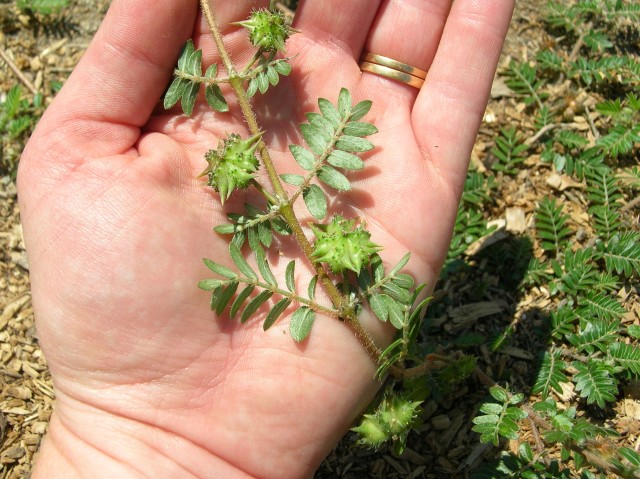Stop the invasion!
You have an opportunity to actually stop an invasion! It’s rather thrilling to know that you can stop an invasive species before it damages the ecosystem, harms animals and people and becomes expensive and time consuming. A Puncturevine (Tribulus terrestris) plant and rosette were found on Kerr Creek Road between Midway and Greenwood last year. It is the first sighting that we know of in our region. There is lots of it in the Okanagan but now it has made its way here. “It could be anywhere so we need you to keep a look out for it,” says Barb Stewart, co-ordinator for the Boundary Weed Management Committee. “Puncturevine has several other names that it is known as including Goathead, Mexican sandbur, and Yellow vine. Puncturevine likes sandy, gravely soils and does well in hot dry climates so areas like Midway and Grand Forks are especially at risk for invasion.” Puncturevine originates in the Mediterranean. It is thought to have arrived in North America via importation of livestock. Puncturevine grows as an annual in climates like the Boundary’s but can be a perennial in warmer climates. Puncturevine has trailing stems that branch out from the centre which form dense mats that can be 2 meters across. The plants usually grow flat along the ground. The leaves grow in opposite pairs along the stem. The whole plant is covered in hairs. It has a taproot with a network of fine little hairs that help it to survive extreme drought. It has bright yellow flowers that look a bit like buttercups. The flowers appear from June to September. Puncturevine spreads by seed. The seeds are contained in hard, very sharp pods. Each pod has five chambers each containing two to four seeds. The seeds can remain dormant in the soil for up to seven years. The sharp spines will pop your bicycle tire and can really hurt your feet if you have thin soled footwear on. It has even been known to flatten light truck tires. Although some reports say the weed can cause photo-sensitivity in animals, the more likely danger is injury from the spiny seed pods. If you find anything that you think is puncturevine please dig or pull it out, and if it has seed pods on it check the ground to make sure you get as many of the seeds as possible, put it all in a thick bag, mark where you found it and report it to the co-ordinator. For more information on invasive plants or to report them please contact Barb Stewart, the Boundary Weed Program co-ordinator at 250-446-2232 or bwmc@nethop.net .
For more pictures of puncturevine go to: Boundary Weed Management Gallery






















